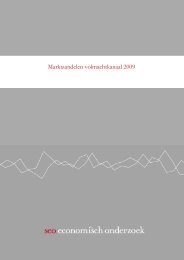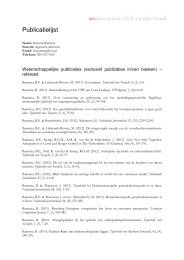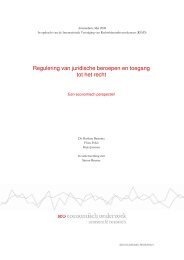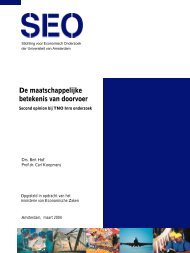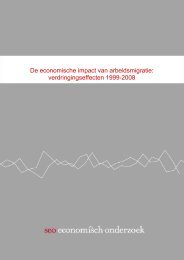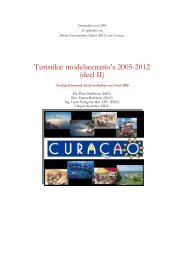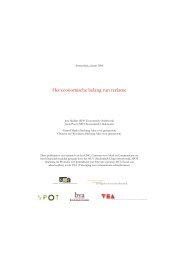Amsterdam, Netherlands - SEO Economisch Onderzoek
Amsterdam, Netherlands - SEO Economisch Onderzoek
Amsterdam, Netherlands - SEO Economisch Onderzoek
You also want an ePaper? Increase the reach of your titles
YUMPU automatically turns print PDFs into web optimized ePapers that Google loves.
7 CONCLUSIONS: MOVING BEYOND THE SELF-EVALUATION7.1 IntroductionIn the distant past <strong>Amsterdam</strong> used to be one of the main trading cities of the world, a positionfavored by its geographical position and the entrepreneurship of its inhabitants. Nowadaysgeography is still an important competitive factor for the <strong>Amsterdam</strong> metropolitan area but less sothan it used to be. In the global economy of today the future is to ‘smart cities’. These aremetropolitan areas succeeding in gaining a competitive advantage by fully exploiting theirpotential for knowledge and innovation. In moving beyond this self-evaluation the questionemerges whether the <strong>Amsterdam</strong> metropolitan area can become one of these smart cities. Itcertainly has much potential if we view the quality and diversity of its educational and researchinstitutes. But it has not yet reached the frontier of most competitive smart cities in the world. Theambition is there. The regional authorities working together in the <strong>Amsterdam</strong> metropolitan areaaim for a position in the top 6 of the Global Business Gateways in the world. What remains is aplan of action to match the ambition.This final chapter reviews the elements which may form part of this plan of action. It starts byassessing the strengths of the region, the points indicating that the quality and diversity of the<strong>Amsterdam</strong> HEIs is already exploited to support innovation as a key economic driver. It thencontinues by discussing the region’s most important weak points. The final section closes with aview into the future. How can the HEI-sector be used more effectively in supporting thetransformation from an industrial economy towards a knowledge-based services economy? Whatare the actions needed to bring the <strong>Amsterdam</strong> metropolitan area closer to the competitivefrontier? We use two scenario’s, called global competition and regional communities, to answerthese questions.7.2 The contribution of HEIs to city and regional developmentA region in transformation..Reviewing the critical success factors for city and regional development is not an easy task. Thisreport has described a great variety of projects and initiatives allowing HEIs to contribute to cityand regional development. In the <strong>Amsterdam</strong> metropolitan area they prove important drivers ofproductive capital and technological growth, which is shown by the above average share ofhigher educated workers in the labor population. They are also the catalysts for network buildingwhich allows social capital to develop and add critical mass to the quantity of creative capitalwhich is becoming a major source of entrepreneurship and innovation in the <strong>Amsterdam</strong> region.The picture which emerges is that of an economic system in transition. The waves of globalcapitalism gradually pull <strong>Amsterdam</strong> from its industrial roots and push it further and further inthe direction of a services economy in which knowledge skills are key. The HEIs in the region arethe facilitators of this process.…and the key drivers for successThe HEIs cannot perform this task alone. They are nodes in a dynamic chain of regionalstakeholders together forming the regional innovation system. The critical success factors inestablishing this system are of a diverse nature. A first and very important factor is the sharedsense of urgency. All parties concerned recognize the need for increased cooperation as a meansto improve innovation as an economic engine for the region. The HEIs play their part in thisprocess by offering world class education and research. They also increasingly aim to match theiroffer of knowledge and skills to the demand from the region, which has resulted in jointstructures for consultation such as the Kenniskring and the establishment of clustered activities innew and dynamic economic hotspots like the life sciences and the creative industry. The business127



